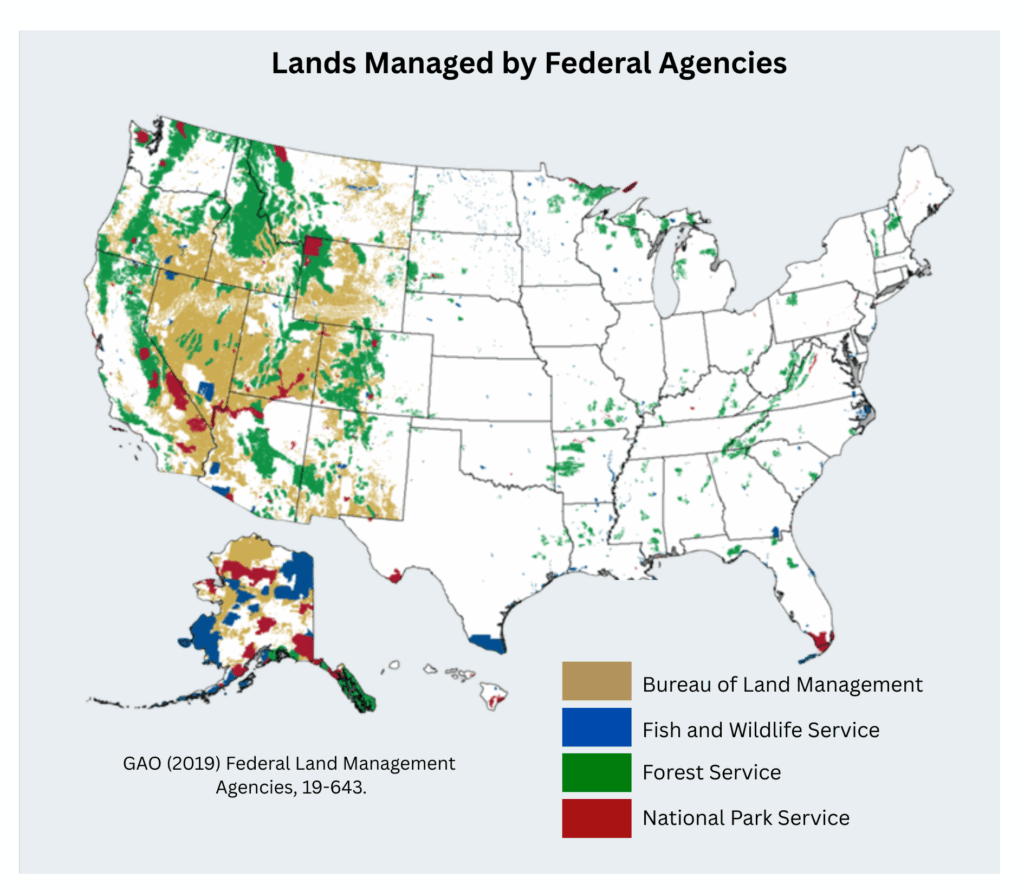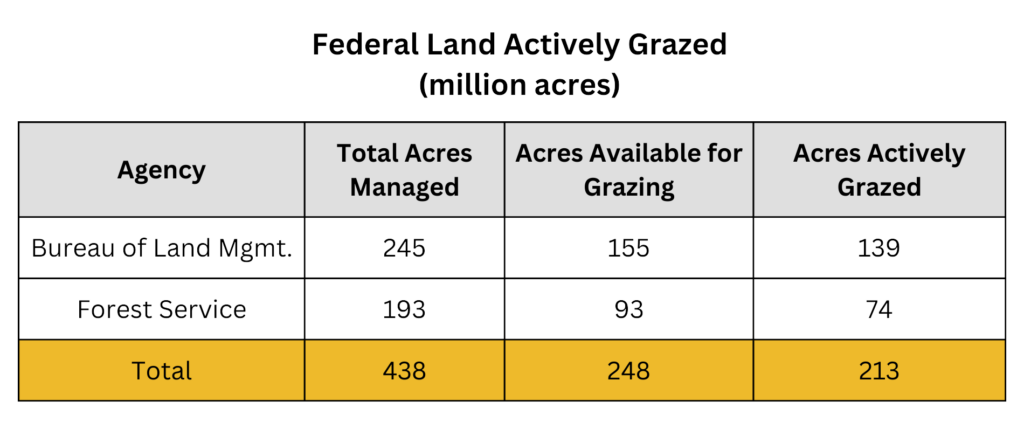The two primary agencies that manage grazing on federal (public) lands are the Bureau of Land Management (BLM) and the Forest Service (FS).
There are ~252 million acres of federal land available for grazing. Land available for grazing does not necessarily mean that it is being actively grazed.[1]
The BLM makes available ~155 million acres for grazing.[2] The BLM manages a total of 245 million acres.[3] This is more federal land than any other agency. More than 99% of the land managed by the BLM is in 11 contiguous western states and Alaska.[4]
The FS made available more than 93 million acres for grazing as of 2017.[5] The Forest Service manages 193 million acres, predominantly in the west.[6]
About 4 million acres are managed for grazing by other federal agencies, with the National Park Service being the largest.[7]
The federal government owns roughly 640 million acres, ~28% of the 2.3 billion acres of land in the United States.[8,9] About 406 million acres of federal lands are in the contiguous U.S.[10]

Congressional Research Service (2019) Grazing Fees: Overview and Issues, RS21232, p. 1. [acreage available may not be used “due to voluntary nonuse for economic reasons, resource protection needs, and forage depletion caused by drought or fire, among other reasons.”]
Bureau of Land Management, Livestock Grazing on Public Lands
https://www.blm.gov/programs/natural-resources/rangelands-and-grazing/livestock-grazing [“The BLM manages livestock grazing on 155 million acres of those lands.”]U.S. Dept. of the Interior, Bureau of Land Management (2023) Public Land Statistics 2022, Table 1.3, pp. 7-8. [244,523,653 acres]
Congressional Research Service (Feb. 21, 2020) Federal Land Ownership: Overview and Data, Summary, Report R42346, p. 4. https://crsreports.congress.gov/product/pdf/R/R42346
Grazing Fees: Overview and Issues, p. 1.
USDA Forest Service (2021) Grazing Statistical Summary Fiscal Year 2021, p. 5.
U.S. GAO (2005) Livestock Grazing, Federal Expenditures and Receipts Vary, Depending on the Agency and the Purpose of the Fee Charged, GAO-05-869, p. 16-17.
CRS (2020) Federal Land Ownership: Overview and Data, Summary, p. 1. [About 615M acres are managed by 5 agencies — the rest by a variety of other government agencies. “Total federal land in the U.S. is not definitively known.”]
GAO (2019) Federal Land Management Agencies: Additional Actions Needed to Address Facility Security Assessment Requirements, GAO-19-643, p. 7.
USDA (2020) Summary Report: 2017 National Resources Inventory, Natural Resources Conservation Service and Center for Survey Statistics and Methodology, Iowa State University, p. 2-1.

As of 2017, about 139 million acres of BLM land were used for grazing, or ~57% of the total lands managed by BLM.[1,2]
About 74 million acres of FS land were used for grazing, or ~40% of the total lands managed by FS.[3]
Acreage actively used for grazing is less than the acreage available “due to voluntary nonuse for economic reasons, resource protection needs, and forage depletion caused by drought or fire, among other reasons.”[4,5]
Figures for the chart are taken from the most recent years for which the agencies publish information. See prior questions for references. Does not include approximately 4 million acres managed by National Park Service and other federal agencies.
Congressional Research Service (2017) Statistics on Livestock Grazing on Federal Lands: FY2002 to FY2016, R44932, p. 2.
USDA Forest Service (2021) Grazing Statistical Summary Fiscal Year 2021, p. 5.
Congressional Research Service (2019) Grazing Fees: Overview and Issues, RS21232, p. 1.
Congressional Research Service (2020) Federal Land Ownership: Overview and Data, Report R42346, p. 20. [In the contiguous U.S., the BLM manages a total of 172.9M and the FS manages 170.8M acres. See Table 2, p. 9, and Table 5, p. 20]
Both the BLM and FS issue grazing permits that specify the amount of time animals can graze. Permits also stipulate forage use and season of use. They are issued to private operators generally for 10 years.[1,2]
Neither agency issues permits for a precise number of livestock. Instead, they authorize the number of animal unit months or AUMs. The BLM defines an AUM as “the amount of forage needed to sustain one cow, five sheep, or five goats for 1 month.”[3]
Bureau of Land Management, Livestock Grazing on Public Lands. https://www.blm.gov/programs/natural-resources/rangelands-and-grazing/livestock-grazing
USDA Forest Service (2021) Grazing Statistical Summary Fiscal Year 2021, p. 115.
U.S. Dept. of the Interior, Bureau of Land Management (2023) Public Land Statistics 2022, p. 241.
BLM: For 2022, the agency “authorized” about 8.5 million AUMs.[1]
FS: For 2021, the agency “authorized” about 6.2 million AUMs.[2]
The BLM defines an AUM as, “the amount of forage needed to sustain one cow, five sheep, or five goats for 1 month.”[3]
Bureau of Land Management (2023) Public Land Statistics 2022, Vol. 207, Table 3-8c, p. 77. [Our understanding of “authorized” means AUMs actually used and invoiced as opposed to AUMs that “could be authorized.” (see, Table 3-9c) The BLM clarifies that, “These animal unit months were calculated for grazing authorized on bills that were due during FY 2022.”]
USDA Forest Service (2021) Grazing Statistical Summary Fiscal Year 2021, p. 8. [The FS clarifies that “authorized” means “Livestock that are authorized and billed for grazing on National Forest System land for that grazing season.” at p. 123.]
U.S. Dept. of the Interior, Bureau of Land Management (2023) Public Land Statistics 2022, p. 241.
Not with certainty. This is partially because the BLM does not specify the number of cattle grazing.[1]
The Forest Service does report the number of permitted cattle at 1.2 million head as of 2021, while the corresponding AUMs were 6.2 million.[2] Applying that same ratio to the 8.5 million AUMs for BLM would suggest a cattle total of ~1.6 million.[3,4] Thus, it might be broadly estimated that ~2.8 million authorized cattle graze on federal lands.
The extent of unauthorized grazing is “largely unknown.” Though it is regularly acknowledged, it is unevenly documented by agencies, so how common it is would be difficult to ascertain.[5-7]
Bureau of Land Management, Q&A’s: Grazing Leases & Permits. https://www.blm.gov/sites/blm.gov/files/orwa-sdpriority-serving-grazing-QandA.pdf
USDA Forest Service (2021) Grazing Statistical Summary Fiscal Year 2021, p. 8. [Cattle number = 1,187,282]
Note: There are caveats with this calculation since the data is not year-to-year, we can’t calculate how long livestock stay on the land, whether there are differences in AUM calculations between agencies, and we have not compared the numbers of other types of animals except for goats and sheep, which are proportionally similar at ~5-7% of total AUM’s. Estimating total cattle grazed at somewhere between 2.5 and 3 million is probably a reasonable estimate.
The BLM calculation above is similar to an estimation of 1.5 million cattle in: Chandra Rosenthal (2022) Home of the Range: Wild Horses on Public Lands, Public Employees for Environmental Responsibility (PEER). https://peer.org/commentary-wild-horses-public-lands/
U.S. GAO (2016) Unauthorized Grazing: Actions Needed to Improve Tracking and Deterrence Efforts, GAO-16-559, p. 12. [“The frequency and extent of unauthorized grazing on BLM and Forest Service lands are largely unknown because according to agency officials the agencies prefer to handle most incidents informally and do not record them.”]
Congressional Research Service (2019) Grazing Fees: Overview and Issues, RS21232, p. 9-10.
Center for Biological Diversity (2022) Re: Sixty-Day Notice of Intent to Sue the U.S. Forest Service and the U.S. Fish and Wildlife Service Pursuant to the Endangered Species Act – Continued Implementation of Forest Plans in the Southwest Region, p. 3. [“In this Notice, we present numerous examples of significant cow grazing impacts in areas where cow grazing is not allowed.”]
Assuming that the actual grazing numbers are ~2.8 million cattle (see previous question), this would be less than 5% of the approximately 57 million cattle grazing in 2024.
That would make the stocking density on federal lands approximately one-tenth the density on private lands.[1]
Very broadly estimated, 252 million available federal acres / 2.8 million cattle = 90 acres per cattle. Total grazing acreage of 798M acres – 252M Federal acres = approx. 550 million private acres / 56 million cattle (59M total grazing – 3M on federal land) = about 10 acres per cattle. (Not accounting for goats, sheep, horses, etc., with much smaller AUMs)
The federal fee for 2024 was set at $1.35 per animal unit month (AUM).[1]
Grazing fees have ranged from $1.35 to $2.11 during the past twenty years.[2]
BLM, USDA Forest Service announce 2024 grazing fees. (January 31, 2024) https://www.blm.gov/announcement/blm-usda-forest-service-announce-2024-grazing-fees [Both agencies charge the same grazing fee per AUM]
Congressional Research Service (2019) Grazing Fees: Overview and Issues, RS21232, p. 4.
The USDA reports that the average grazing fee per AUM on private lands for 2023 was $22.00. The average fee varied by state with Oklahoma at a low of $11.00 and Nebraska at a high of $44.50.[1]
The current federal grazing fee of $1.35 per AUM is ~6% of the average cost of private grazing fees.
USDA NASS (January 2024) Grazing Fees: Animal Unit Fee, 17 States, 2022 and 2023. https://www.nass.usda.gov/Charts_and_Maps/Grazing_Fees/gf_am.php
The public grazing fee reflects a general understanding that the agencies’ purpose is not to capture fair-market value or even recover administrative costs. Rather, grazing is allowed on federal land in large part to foster economic development for the ranching communities.[1-3]
The BLM and FS grazing fee was established under the Public Rangelands Improvement Act of 1978 (PRIA) at a time when the fee was considered fair market value. The first fee was implemented at $2.31 in 1981.[4,5] The inflation-adjusted 1981 cost of $2.31 is now about $10.20. This is ~8 times the current fee of $1.35.[6]
In 2015, the BLM acknowledged that the collected grazing fees were less than half of what it cost to administer to program.[7] And when calculating the social costs of carbon from the livestock grazing program, a 2022 study found that those costs exceeded what the fees generate by ~26 times.[8]
U.S. GAO (2005) Livestock Grazing, Federal Expenditures and Receipts Vary, Depending on the Agency and the Purpose of the Fee Charged, GAO-05-869, p. 16. [“Grazing is allowed on BLM and Forest Service lands for the purpose of fostering economic development for private ranchers and ranching communities by providing ranchers access to additional forage.”]
U.S. Forest Service, Why does the Forest Service permit livestock grazing on National Forest System lands? https://www.fs.usda.gov/rangeland-management/grazing/allowgrazing.shtml
Congressional Research Service (2019) Grazing Fees: Overview and Issues, RS21232, p. 7. [“First, there are differences over which criteria should prevail in setting fees: fair market value; cost recovery (whereby the monies collected would cover the government’s cost of running the program); sustaining ranching, or resource-based rural economies generally; or diversification of local economies.”]
Congressional Research Service (2019) Grazing Fees: Overview and Issues, RS21232, p. 3.
U.S. GAO (2005) Livestock Grazing, Federal Expenditures and Receipts Vary, p. 83.
U.S. Bureau of Labor, CPI Inflation Calculator (as of October 2024)
Bureau of Land Management, Livestock Grazing on Public Lands. https://www.blm.gov/programs/natural-resources/rangelands-and-grazing/livestock-grazing [In fiscal year 2015, the agency spent $36.2 million dollars on grazing administration and collected $14.5 million in grazing fees.]
Kauffman, J. B., et al., (2022). Livestock Use on Public Lands in the Western USA Exacerbates Climate Change: Implications for Climate Change Mitigation and Adaptation. Environmental Management, 69(6), 1137–1152, p. 1147. [The social cost of carbon (SCC) is “an estimate of the monetized damages associated with incremental increases in greenhouse gas emissions. It represents the present value of the marginal social damages of increased GHG emissions in a particular year—including the impacts of global warming on agricultural productivity and human health, loss of property and infrastructure to sea level rise and extreme weather events, diminished biodiversity and ecosystem services, etc.—and therefore it also represents the marginal social benefits of emissions reductions.”]
